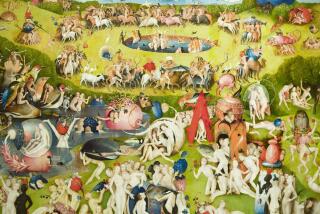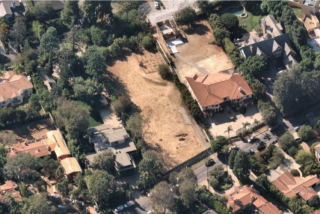After Eden : A SENSE OF PLACE, A SENSE OF TIME, <i> By John Brinckerhoff Jackson (Yale University Press: $22.50; 212 pp.)</i>
What happened to Adam and Eve after they were driven out of the Garden of Eden is known well enough: toil, bills and our hard history. Has anyone asked what happened to the Garden? With no one to tend it, presumably it reverted to wilderness; a state of affairs no doubt satisfactory to the Sierra Club and other strong greens, but one that would clearly displease John Brinckerhoff Jackson.
âI have no particular liking for wilderness and forest,â this lifelong student, writer and teacher of the history of the American landscape asserts. He does like trees, though.
It is a provocation--in the course of these genially idiosyncratic pieces, it becomes clear that Jackson floats lure and hook in hopes we will snap at them--but not necessarily a contradiction. Wilderness extremists, he believes, fail to see the trees for the forest. The greatest oaks, elms and maples, not to mention apple and peach trees, stand in orchards, on town greens and at woods edge.
People have planted them or, at least, cut around them. If trees grow large and beautifully formed in the forests of Europe, it is because a lot of tending and clearing goes on; and even in the United States foresters have traditionally cut for growth. Human intrusiveness? Jackson is all in favor. Human beings are not, or are not only, the guardians of ecology. They are ecology--as much as beavers, droughts, insect borers and funny genes; and in general, smarter.
The author is outraged by environmental radicalism, which he compares to âsome obscure Christian heresy in which the cross would be interpreted as the symbol of the dismembered forest tree, and death is seen as merely the first step in the producing of compost for the man-ravished planet.â For him, on the contrary, the supreme natural landscape is one that bears frequent if not universal marks of humanity. Garden is closer to it than wilderness.
âIf the study of nature means anything more than the study of the wilderness--and most current writing leaves one in doubt--it also means the study of crops and soils and weather, and the landscapes farmers and ranchers and gardeners create: it always includes the human contribution,â he writes.
The essays in this collection, written in the years since Jackson retired from teaching at Berkeley and Harvard, do a prickly ramble over a variety of topics. He writes affectionately about Pueblo adobe houses but sees the human virtues of the mobile homes that have replaced many of them. He is for information centers, restrooms, parking lots and cleared recreational spaces in national parks.
He writes against the myth of the forest primeval, noting the active reshaping of the forest done by Native Americans long before the Mayflower. He writes of the highway as a place to be and not just to travel along. He suggests that the inner city, devastated by the automobile, is being knit together by the vitality of immigrant artisans and entrepreneurs driving untidy second-hand vans and pickup trucks (and, presumably, gypsy cabs).
He is an advocate of beauty and of people; an anti-snob populist and yet--I expect he would resent the word--an aesthete. He loves nature but also the use made of it; and not only by educated environmentalists who take nothing from the forest but inner renewal, and leave nothing but footprints. He also, perhaps mostly, speaks up for less privileged people who like to drive there, canât muster time, money and belief for the expensive austerity of correct camping, want to picnic and play ball, and donât imagine going to the woods and not picking up a fern or an interesting rock.
Jackson will annoy everyone; on the other hand, different people will be annoyed in different places. Dividing, to a considerable extent he conquers. His anti-elitism can go to odd and infuriating extremes but it departs from premises that are not merely humane, but shrewd and perceptive as well.
Take the car. There is the freedom and mobility it offers across almost all social classes, in a society that is becoming more stratified. But there is something else, he suggests. The author attended an automobile repair course; he noted the rigor and thoroughness with which the instructor led the class, whose members mostly belonged to the young urban poor. âLearning to be a good auto mechanic is learning to be civilized,â he writes. âIt cannot teach you the difference between good and evil but . . . it can teach you the difference between right and wrong, between correctness and sloppy, dishonest work.â
This is all very well, but his photographs of a motorcycle standing in the woods, and of forest picnickers flanked by three parked cars make us wince--even as he is arguing that nature should be widely, not narrowly accessible. And as he wickedly traces a connection between 19th-Century British aristocrats who forbade their woods to their peasantry, and environmentalists who would keep out working-class families with picnic coolers, disposable diapers for an unsightly number of babies, and plastic chairs for non-disposable grandparents.
He contrasts, unfavorably, the deliberately serene and bucolic effect of Frederick Law Olmsteadâs urban parks with the raffish energy of a mall or flea market; as if only the latter were authentically, as he puts it, âvernacular.â Has he never seen the intense, overwhelming use that people make of Olmsteadâs Central Park and of his Jamaica Pond, in a multicultural, economically mixed part of Boston? Is there an unconscious condescension in the assumption that the common people must be as noisy and lusty as in a Breughel town-scape; and donât want a quiet greenery and the sound of breeze and birds? In fact, there is not. Jackson is an original and a battler and most of his battles are against condescension; perhaps you canât fight without getting a little of the enemy on your hands.
I disagree with quite a few things in his book. Some of his sorties are dead-ends, made out of the pleasure of sortying and seeing what you find. His belief that what masses of people are engaged in will eventually turn out well doesnât make his amiable case for the new primacy of road over place. Roads--10-lane highway replacing eight-lane, and just as crowded--may in fact devour their destinations; but that does not negate the fact that without places to go, roads have no meaning.
Yet his vision, enlivened by a long lifeâs treasure of details--in parts of Kansas, settled along the geographical grids decreed by Thomas Jefferson, the burners on a stove are still called northeast, southwest and so on--is arresting; the more so, perhaps, for being both traditional and out of fashion. Mankind is in nature, not apart from it; and a few of the marks made by civilization over the millennia--the dolmens of the Celts, the mysterious circular earthworks of Nazca in Peru, the checkered green downs of Somerset, the way an Italian town clings to its hill--these things carve the world as miraculously as a river, a glacier or a seed-bearing wind.
More to Read
Sign up for Essential California
The most important California stories and recommendations in your inbox every morning.
You may occasionally receive promotional content from the Los Angeles Times.










